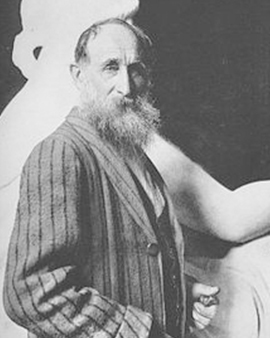


Aristide Maillol was a French sculptor, painter and graphic artist who was born on December 8, 1861 in Banyuls-sur-Mer, Pyrénées-Orientales department and died there on September 27, 1944. In France, he was considered an important counterpart of Auguste Rodin and had a lasting influence on European sculpture in the first half of the 20th century. Maillol was the fourth of five children of cloth merchant and vineyard owner Raphaȅl Maillol and his wife Cathérine, née Rougé. His family came from a line of winemakers, sailors, and smugglers. His birthplace, the fishing village of Banyuls-sur-Mer, is located on the Mediterranean Sea near the Spanish border. Maillol's native language was Catalan; he spoke French with a heavy accent.
After elementary school, he attended the Collège Saint-Louis in Perpignan, where he developed a desire to become an artist in art classes. This desire was not understood by his family at first. In 1881, at the age of 20, Maillol moved to Paris to study art. He first attended a drawing course at the École des Beaux-Arts as a free student, led by the painter and sculptor Jean Leon Gerome. After a few months, he transferred to the School of Decorative Arts, where he took sculpture courses. Later he returned to the École des Beaux-Arts and was accepted into the class of the salon painter Alexandre Cabanel.
Maillol lived in extreme poverty in and around Paris for nearly twenty years. In 1894 he moved to Paris with Clotilde Narcis, one of his employees at the tapestry studio in Banyuls. They married in July 1896, and in October of that year their only child, Lucien, was born. Clotilde became Maillol's ideal model in painting, textile art, and sculpture for more than a decade. Maillol's recognition grew gradually. In 1904 Julius Meier-Graefe included him in his important publication History of the Development of Modern Art. That same year, the artist met his most important patron, Harry Graf Kessler, for whom he executed some of his major works. Maillol's artistic beginnings were as a painter, but he was strongly influenced by Pierre Puvis de Chavannes and Paul Gauguin. In the 1890s, Maillol turned to making tapestries. In 1893, he set up a small tapestry studio in his home village of Banyuls.
From the mid-1890s, he worked primarily as a sculptor. At first, he carved small reliefs. In time, however, he began to carve wooden figures about 60 cm high. These works showed a consistent restriction to the elementary forms of the body and a high sensitivity to the materiality of the wood. These early sculptures laid the foundation for Maillol's later works, which are known for their classicist simplicity and strong focus on the physical forms of the female body. Despite being limited to a rather small size, these works exude an enormous calm and dignity that underscore Maillol's unique artistic vision.

Aristide Maillol was a French sculptor, painter and graphic artist who was born on December 8, 1861 in Banyuls-sur-Mer, Pyrénées-Orientales department and died there on September 27, 1944. In France, he was considered an important counterpart of Auguste Rodin and had a lasting influence on European sculpture in the first half of the 20th century. Maillol was the fourth of five children of cloth merchant and vineyard owner Raphaȅl Maillol and his wife Cathérine, née Rougé. His family came from a line of winemakers, sailors, and smugglers. His birthplace, the fishing village of Banyuls-sur-Mer, is located on the Mediterranean Sea near the Spanish border. Maillol's native language was Catalan; he spoke French with a heavy accent.
After elementary school, he attended the Collège Saint-Louis in Perpignan, where he developed a desire to become an artist in art classes. This desire was not understood by his family at first. In 1881, at the age of 20, Maillol moved to Paris to study art. He first attended a drawing course at the École des Beaux-Arts as a free student, led by the painter and sculptor Jean Leon Gerome. After a few months, he transferred to the School of Decorative Arts, where he took sculpture courses. Later he returned to the École des Beaux-Arts and was accepted into the class of the salon painter Alexandre Cabanel.
Maillol lived in extreme poverty in and around Paris for nearly twenty years. In 1894 he moved to Paris with Clotilde Narcis, one of his employees at the tapestry studio in Banyuls. They married in July 1896, and in October of that year their only child, Lucien, was born. Clotilde became Maillol's ideal model in painting, textile art, and sculpture for more than a decade. Maillol's recognition grew gradually. In 1904 Julius Meier-Graefe included him in his important publication History of the Development of Modern Art. That same year, the artist met his most important patron, Harry Graf Kessler, for whom he executed some of his major works. Maillol's artistic beginnings were as a painter, but he was strongly influenced by Pierre Puvis de Chavannes and Paul Gauguin. In the 1890s, Maillol turned to making tapestries. In 1893, he set up a small tapestry studio in his home village of Banyuls.
From the mid-1890s, he worked primarily as a sculptor. At first, he carved small reliefs. In time, however, he began to carve wooden figures about 60 cm high. These works showed a consistent restriction to the elementary forms of the body and a high sensitivity to the materiality of the wood. These early sculptures laid the foundation for Maillol's later works, which are known for their classicist simplicity and strong focus on the physical forms of the female body. Despite being limited to a rather small size, these works exude an enormous calm and dignity that underscore Maillol's unique artistic vision.
Page 1 / 2






